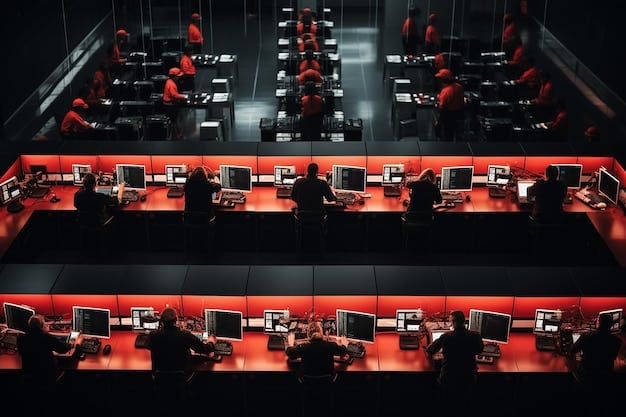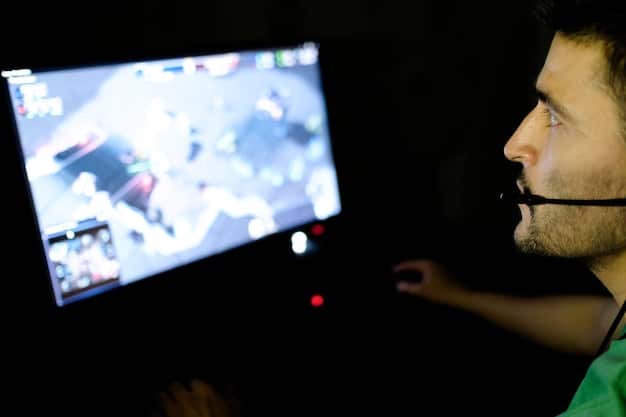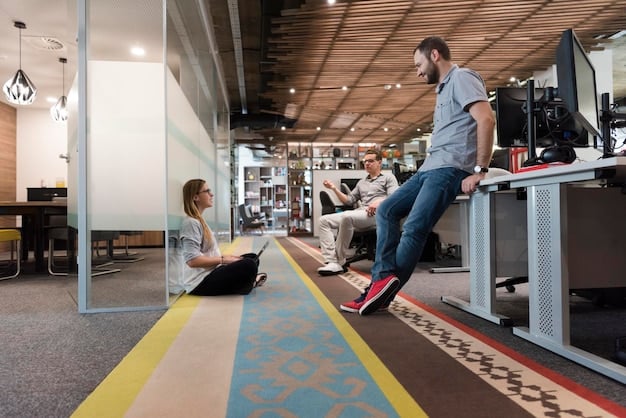New Esports Training Facilities in the US: Investment and Growth

Esports training facilities are rapidly expanding across the US, fueled by significant investments and the growing popularity of competitive gaming, providing state-of-the-art resources for aspiring esports athletes.
The landscape of esports in the United States is undergoing a significant transformation with the rise of dedicated esports training facilities. These state-of-the-art centers are designed to cultivate the next generation of competitive gamers, offering a blend of advanced technology, expert coaching, and comprehensive player development programs.
The Rise of Esports Training Facilities
The esports industry is no longer a niche market; it’s a global phenomenon with millions of viewers and players. As the stakes get higher, the need for structured training environments becomes crucial. This has led to a surge in investments in esports training facilities across the United States.
These facilities are more than just gaming centers; they are comprehensive training ecosystems equipped with advanced technology, experienced coaches, and resources aimed at enhancing player performance, mental resilience, and overall well-being.
Why Invest in Esports Training Facilities?
Investing in esports training facilities offers numerous benefits for players, teams, and the industry as a whole:
- Professional Development: Structured training programs help players develop their skills, strategies, and teamwork.
- State-of-the-Art Equipment: Access to high-end computers, peripherals, and software enhances the training experience.
- Expert Coaching: Experienced coaches provide guidance on gameplay, strategy, and mental fortitude.
- Competitive Edge: Well-trained players are more likely to succeed in tournaments and leagues.
Ultimately, these facilities contribute to the professionalization of esports, making it a more sustainable and attractive career path for aspiring gamers.
The growing investment in these esports training facilities signals a strong belief in the future of competitive gaming and the potential for American talent to dominate the global stage.
Key Features of Modern Esports Training Centers
The modern esports training center is designed with the holistic needs of esports athletes in mind. It goes beyond simply providing a space to play games, incorporating elements of physical and mental well-being, performance analytics, and community building.
Let’s delve into the key features that set these facilities apart:
Advanced Technology and Equipment
State-of-the-art training centers are equipped with high-end gaming PCs, ergonomic chairs, low-latency internet connections, and advanced display technology. This ensures that players have access to the best tools to hone their skills.
Coaching and Analytics
Experienced coaches provide personalized training plans, analyze player performance, and offer feedback on strategy and gameplay. They use data analytics tools to identify areas for improvement and optimize training regimens.
Physical and Mental Wellness Programs
Understanding the importance of physical and mental health, these facilities often include fitness centers, nutrition programs, and mental wellness resources to help players maintain peak performance levels.

The integration of these diverse elements makes esports training facilities comprehensive hubs for developing well-rounded and competitive esports athletes.
Examples of Leading Esports Training Facilities in the US
Several pioneering esports training facilities have emerged across the United States, setting the standard for player development and competitive excellence. These facilities represent a significant investment in the future of American esports.
Here are some notable examples:
Complexity Gaming’s GameStop Performance Center
Located in Dallas, Texas, Complexity Gaming’s GameStop Performance Center is a sprawling facility that provides players with top-tier equipment, coaching, and wellness resources. It serves as a central training hub for Complexity’s various esports teams.
100 Thieves Cash App Compound
Based in Los Angeles, California, the 100 Thieves Cash App Compound is a cutting-edge esports facility that includes training rooms, streaming pods, content creation studios, and a retail store. It’s designed to foster a vibrant community and support the growth of 100 Thieves’ esports teams and content creators.
Nerd Street Gamers’ Localhost Facilities
Nerd Street Gamers operates a network of Localhost facilities across the country, providing accessible training and competition venues for amateur and aspiring esports players. These facilities offer a range of programs and events, from casual gaming sessions to competitive tournaments.
- East Coast Presence: Expansive reach on the East Coast
- Community Focus: Emphasis on building local scenes
- Development Programs: Structured training for amateurs
These examples showcase the diversity of esports training facilities in the US, ranging from high-performance centers for professional teams to community-focused venues for amateur players.
The Impact of Esports Training Facilities on Player Development
The emergence of dedicated esports training facilities has had a profound impact on player development, providing aspiring professionals with the resources and support they need to succeed.
Let’s explore some key benefits:
Structured Training and Skill Enhancement
Training facilities offer structured programs that focus on skill development, strategic thinking, and teamwork. Coaches provide personalized guidance and feedback, helping players identify and overcome their weaknesses.
Improved Mental Fortitude and Resilience
Esports can be mentally taxing, requiring players to perform under pressure and cope with intense competition. Training facilities address this by incorporating mental wellness programs, stress management techniques, and strategies for building resilience.
Networking and Collaboration Opportunities
Training facilities bring together players from different backgrounds and skill levels, fostering a sense of community and collaboration. This provides opportunities for networking, mentorship, and knowledge sharing.

The presence of these facilities is contributing to a more professional and sustainable esports ecosystem, where players have the resources they need to thrive.
Challenges and Opportunities in the Esports Training Landscape
While the growth of esports training facilities is encouraging, the industry still faces challenges. Addressing these hurdles is crucial for realizing the full potential of these facilities and ensuring their long-term success.
Here are some key points to consider:
Sustainability and Funding
Operating an esports training facility can be expensive, requiring significant investments in equipment, personnel, and marketing. Securing sustainable funding models and attracting sponsors are essential for long-term viability.
Accessibility and Inclusivity
Ensuring that esports training facilities are accessible to players from diverse backgrounds and skill levels is crucial for fostering inclusivity. This may involve offering scholarships, community programs, and resources for underrepresented groups.
Regulation and Standardization
The esports industry lacks standardized regulations and guidelines, which can create uncertainty and inconsistency. Establishing clear rules and standards for training facilities can help ensure quality and protect the interests of players.
Overcoming these challenges will pave the way for a more robust and equitable esports training landscape, benefiting players and the industry as a whole.
The Future of Esports Training Facilities in the US
The future of esports training facilities in the US looks promising, with continued investment, innovation, and a growing focus on holistic player development. These facilities are poised to play an increasingly important role in shaping the future of competitive gaming.
Here are some trends to watch:
Integration of Advanced Technologies
Expect to see greater integration of advanced technologies such as virtual reality, augmented reality, and artificial intelligence in esports training programs. These technologies can provide immersive training experiences, personalized feedback, and data-driven insights.
Expansion of Educational Partnerships
Esports training facilities are likely to forge stronger partnerships with educational institutions, offering academic programs, scholarships, and career pathways for aspiring esports professionals. This can help legitimize esports as a viable career option and attract a wider pool of talent.
Growing Emphasis on Mental Wellness
As awareness of mental health issues in esports rises, training facilities will place greater emphasis on providing mental wellness resources and support for players. This may involve hiring sports psychologists, offering counseling services, and implementing stress management programs.
| Key Point | Brief Description |
|---|---|
| 🚀 Esports Growth | US sees a surge in esports facilities, fueled by rising popularity. |
| 💻 Tech & Training | Facilities offer advanced tech, coaching, and wellness programs. |
| 💪 Player Development | Improving skills, mental strength, and collaboration among players. |
| 💰 Investment | Sustainable funding and accessibility are key for future growth. |
Frequently Asked Questions (FAQ)
Esports training facilities are dedicated centers equipped with high-end technology and resources to help aspiring gamers improve their skills in competitive video gaming.
They provide structured training, expert coaching, and a supportive environment, essential for developing the next generation of professional esports athletes in the US.
Typically, they include high-performance computers, ergonomic chairs, low-latency internet, and advanced display technology, ensuring optimal training conditions for players.
Many facilities offer mental wellness programs, counseling services, and stress management techniques to help players cope with the pressures of competitive gaming.
Common challenges include securing sustainable funding, ensuring accessibility and inclusivity for all players, and establishing standardized regulations within the esports industry.
Conclusion
The rise of esports training facilities across the US represents a significant step forward in the professionalization of competitive gaming. These centers not only provide aspiring esports athletes with the resources they need to hone their skills but also contribute to the overall growth and sustainability of the esports ecosystem.





